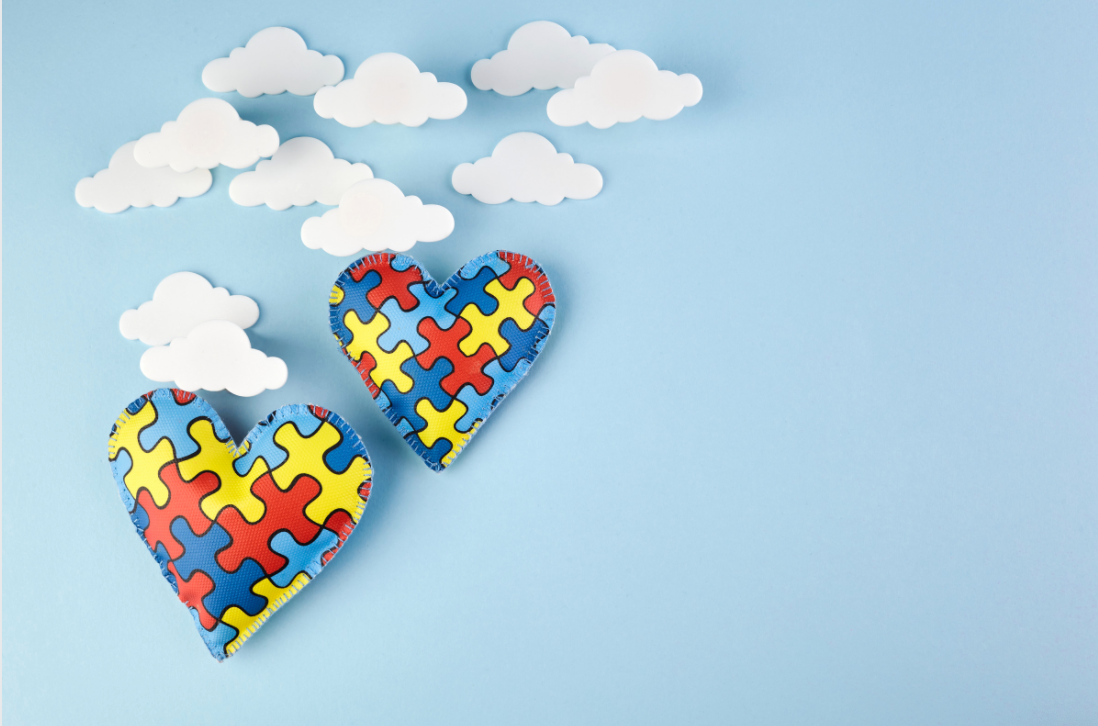Its autism awareness month, which is a wonderful opportunity for anyone interacting with children on the autism spectrum to take a moment and appreciate our neurodiverse individuals. One of the most common comments that I hear from caregivers is that their kids with autism “don’t care” about other people. Although some children with autism prefer to play alone, concluding that they have no interest in human connection is an assumption, and, in my experience, has generally not been true!
What is true is that oftentimes children with autism have narrow interests and sensory sensitivities, struggle with communication, and don’t pick up on the same cues that neurotypical brains do- all of which impact the ability to easily connect with others. Children may lack specific skills to help them make connections, but often have the desire to do so, even if they can’t express it. Connection is one of the most important aspects of the human experience, relevant to everyone. Below is a short description of these components, and some suggestions to help establish, expand upon, and maintain meaningful connections with kids on the spectrum.
Narrow Interests- Some children may have strong interests in particular topics, toys, or items that others are not interested in (such as fans or parts of toys) and have difficulty engaging in conversation or play that is not directly related to their interests. To help facilitate a social connection, show genuine interest in what the child gravitates to and then expand upon it to create more functional play and reciprocal interactions. A child who likes fans may enjoy playing with propeller toys, a child who is preoccupied with parts of toys may enjoy putting together a contraption with pieces, or a child who is academically oriented may enjoy games with words or math (word bingo or Yahtzee). Older children who have a preoccupation with a specific interest may benefit from seeing the “bigger picture-” a child obsessed with the musical Hamilton may enjoy seeing other musicals and learning about composing music or acting. Facilitate turn taking in play and conversation and gradually expand the amount of time spent on an activity together and add new activities/topics into play (if playing scrabble, introduce other board games). Children may benefit from making a schedule of activities for an afternoon, as many children with autism thrive on routine. If introducing new activities, intersperse many preferred tasks throughout in addition to other positive reinforcement!
Sensory Sensitivities- Children with autism are more prone to hypersensitivity to stimuli commonly found in social environments, such as loud noises, bright lights, or being very close to other people. Be aware of the sensitivities of your child/client and provide support and accommodations to avoid feeling overwhelmed- perhaps headphones or sunglasses or starting out in a small group setting with a few familiar people before a large outing such as to a shopping mall or museum (even if the place you are going is preferred). You might even role play what to do in the case of sensory overload (ask for help, squeeze a sensory toy, or take a break). Supporting your child’s sensory needs will help them feel safe when they are with you, which is important in any relationship.
Communication- Many people with autism struggle with both vocal and nonverbal (gestural) communication. Helping the child to communicate in a functional way that matches their needs and skill level is essential. The skills you are teaching must translate across environments- for example, a child who spells words aloud quickly or makes unintelligible whole-word approximations will struggle to communicate with people who aren’t familiar/can’t anticipate the child’s wants/needs and would benefit more from using a communication device.
Important pre-requisites to social communication include imitation, eye contact, and joint attention, all of which can be targets for intervention. Also, some children with autism engage in “scripting,” or repeating things verbatim. Before jumping to intervene, consider what the child is saying and in what context- sometimes, the lines they are repeating are relevant to what is happening, and scripting is a reliable way to communicate. In these cases, say the same idea with different words to expand the child’s verbal repertoire. To help your child improve communication so that they can connect with others, assess their verbal behavior (with your behavior analyst!) and then start with forms of communication that are preferred, slowly building up functional skills through structured programming and naturalistic opportunities.
Children with limited communication will struggle to tell you what they want or need, which can result in tantrums, elopement, or other unwanted behaviors. Helping them find a system that works for them means that they can more reliably tell you what they need. When you then reinforce their appropriate request, you are strengthening your relationship with the child and building trust.
Social Cues- Social cues include understanding gestures, facial expressions, tone of voice, prosody, etc. Note that usually these concepts are usually not taught, as many children acquire these skills naturally, though children with autism may not. You may need to explicitly teach and explain how to read social cues using visual systems, role play, social stories, perspective taking games, and modeling concepts in everyday life. Social cues are important because understanding them improves connection with others (for example, being able to read that someone is not interested in what you are saying and changing the topic). Difficulties with social cues/communication also lead to trouble expressing empathy, which is a keystone of connection. One reason that children with ASD may struggle with empathy lies in the science of mirror neurons, which fire in typical brains both when we perform an action and when we witness someone else performing that same action. They account for our abilities to “read” someone’s mind and feel empathy, in addition to picking up on the intent behind other people’s actions. A person with ASD may have faulty mirror neurons.
To help build empathy, start from the top, as previously mentioned, teaching imitation, eye contact, joint attention, and responding to multiple cues. Provide appropriate vocabulary in every opportunity possible through commentary of feelings, emotional states, facial expressions, and nonverbal cues/gestures. Additionally, specific prompts (for example, asking the child how they feel after they’ve just stubbed their toe, or yelling out “ow!” after you stubbed your toe) can be used to provide opportunities to teach and practice the skill with your child. You can also use books and movies and help your child identify the feelings of the characters and to predict what they might do next. Helping your child understand social cues will make it easier for them to read social situations appropriately and interact more easily with others.
Happy connecting!
About the author: Jessica Savaiano, EdS, NCSP, BCBA, LBS, RYT, is a Nationally Certified School Psychologist, Board Certified Behavior Analyst, Licensed Behavior Specialist, and Registered Yoga Teacher. She currently works as a behavior analyst at Child Guidance Resource Centers and an extern at the Children's Hospital of Philadelphia in the Neuropsychology department and at the Center for Autism Research. Jessica is pursuing a doctoral degree in school psychology from the Philadelphia College of Osteopathic Medicine, completing her dissertation research on the impact of a school-based mindfulness program on students' executive functions. She has previously worked as a school psychologist, serving public and parochial schools in Philadelphia and the surrounding suburbs. Jessica has been teaching yoga since receiving her certification in 2016 and has directly implemented mindfulness/yoga programs with children and teens in addition to providing mindfulness training to professionals and teaching weekly yoga classes to adults.

